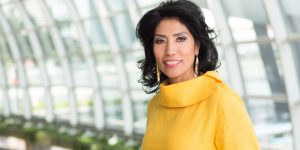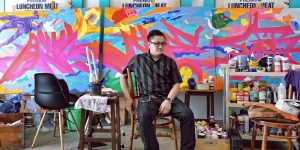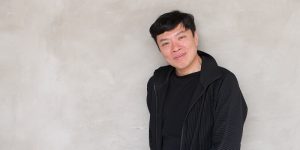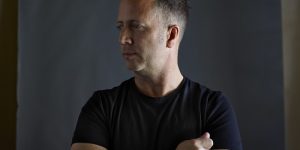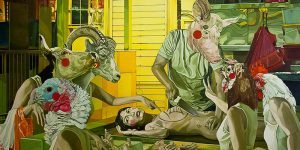Interview with Adeline Ooi
Our friends at Art Republik sit down with the recently appointed Director Asia for Art Basel.
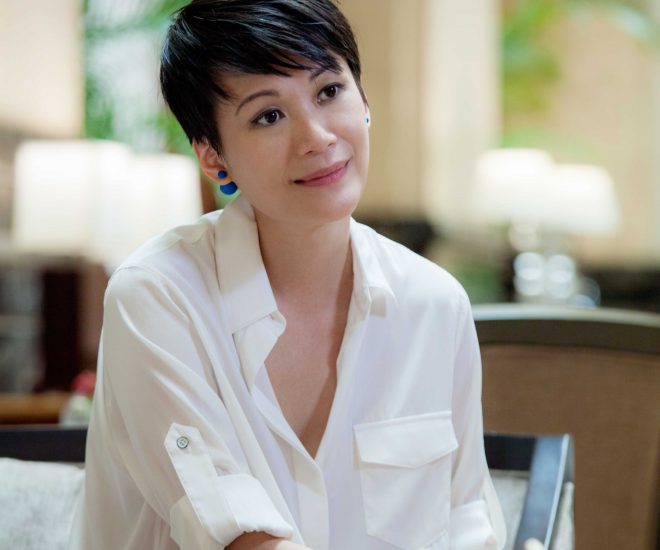
In December 2014, Adeline Ooi was appointed the new Director Asia for Art Basel, succeeding Magnus Renfrew, who left earlier in July 2014 to move to Bonhams. Speaking to Art Republik about the change in directorship, Marc Spiegler, Director of Art Basel, who oversees the three Art Basel fairs in Basel, Miami Beach and Hong Kong, said, “Magnus built up the fair and recruited a lot of great galleries. The first two editions of Art Basel Hong Kong were very successful, so in a sense, the gallery component of the fair is built. But our clients need clients, and so we felt that the next Director Asia’s job was to catalyze the show and take it to the next level.”
In searching for the perfect candidate to do the job, Spiegler revealed that they were looking for someone who was comfortable navigating the art world, and had a broad knowledge of Asia, complemented by a keen familiarity with many of the diverse art scenes within Asia. “We also needed someone with the right combination of intelligence so that they can move quickly, and energy to do the job – a positive energy which gets people excited to go to the fair in Hong Kong,” added Spiegler.
With extensive experience in the art world, Ooi fit the bill. She studied at Central St Martins College of Art and Design in London, majoring in Fine Art. After graduation, she returned to Kuala Lumpur, Malaysia, in 2000, where she worked as curator at Valentine Willie Fine Art. In 2002, she received The Nippon Foundation’s Asian Public Intellectual (Junior) Fellowships Grant and subsequently produced a survey of independent artists’ initiatives in Indonesia and the Philippines.
For the past decade, Ooi has worked on multiple projects related to Indonesian and Filipino contemporary art in different capacities, including project manager and consultant, and has worked with galleries both in the West and in Asia. In 2007, she returned to Valentine Willie Fine Art as curator, before founding RogueArt in 2008, a contemporary Southeast Asian art consultancy. In the past two years, she has been Art Basel’s VIP Relations Manager for Southeast Asia.
Art Republik sits down with Adeline Ooi to find out more about her new role, and what to expect at Art Basel Hong Kong 2015.
First of all, congratulations on your appointment as Director Asia, Art Basel Hong Kong. What attracted you to this new challenge?
I was approached for the job, and was not sure whether I could do it at first. I took a long time to think about it. Eventually, I came to the realization that I had, over the past 15 years of my career, assumed different roles – from being a curator, to a somewhat ‘indie’ academic for a time, to managing a gallery, to being an art adviser, to working on VIP relations for Art Basel for Southeast Asia – which covered the range of sectors of stakeholders that make up the art ecosystem. From this, I understand what the different stakeholders need, and also how to communicate with them. And so I thought that actually, yes, I could do the job.
What are the different skill sets that these experiences have equipped you with? How do you think your background will influence the direction Art Basel in Hong Kong moves going forward?
Right now, I can’t tell you what the five-year plan is, but I think with my background, it’s about opening doors and keeping them open with the different sectors and stakeholders in the art world. I don’t think Marc Spiegler hired me to immediately come up with new ideas about how to change Art Basel. What I think I bring to the table is my ability to communicate with everyone and draw out what is urgent, to discuss and figure out what we all need, and then formulate what is to be done next. I’ve been in the art scene long enough to be sensitive to the climates.
You have worked closely with Southeast Asian art for many years. What is it about Southeast Asian art that continually interests or inspires you?
It’s really the people that inspire me. It’s the people, the passion, the energy. I don’t think it’s just limited to Southeast Asia. It’s a human thing. You go out to Yogyakarta and you see a community that is so dedicated to their scene and the belief of giving back. They come together when they need to and still maintain a healthy competition with each other. Ultimately, it’s about being authentic and being true to yourself. You sense the passion and commitment and it’s inspiring.
What are the most common misconceptions people have about art from the region and how do you go about dispelling these?
I’ve heard from people that Southeast Asian art looks too much like everything they’ve seen. What is considered Indonesian, Singaporean, Filipino in people’s eyes may not translate or may not meet their expectations because we have all been exposed to the Western art language, whether it’s through colonization, our art education or mass media. I think for most people, when you understand that, then you understand that actually what we’re doing is neither contrived nor mimicry. For example, social realism in art from the Philippines may share a similar language with social realism in Mexico, if you think about the parallels in their heritage.
Could you comment on the change of Art Basel’s Hong Kong dates from May to March?
May is a busy month on the art calendar with events such as the auctions in New York, and this year with the opening of Venice Biennale as well. It means that a number of galleries from the West are able to take part in the show for the first time – almost 20 galleries from the West who have exhibited with Art Basel in Miami Beach or Basel will participate in Hong Kong for the first this year – and we are getting news from a number of collectors from the West who are now finally able to visit the fair for the first time as well. The art fair will continue to take place in March from 2016, but will move back from the usual Thursday to Sunday dates from this year’s Sunday to Tuesday dates, which was unavoidable this year due to the busy schedule of the Hong Kong Convention and Exhibition Centre (HKCEC).
The art fair landscape has become crowded. Art Basel in Hong Kong moving to March now competes with TEFAF in Maastricht (13-22 March) and The Armory Show (5-8 March 2015), for example. How do you see Art Basel in Hong Kong holding its own against such strong competitors?
I think it’s a very different crowd. There is very little overlap between the galleries and collectors who would do TEFAF and Art Basel in Hong Kong. And there are galleries and collectors who do both, The Armory Show and then Art Basel in Hong Kong. Let’s just say there’s no perfect timing but for the crowd we’d like to draw to Hong Kong, it works. And it’s quite a nice time after Chinese New Year to have a spring fair.
With six sectors: Galleries, Insights, Discoveries, Encounters, and Film, Art Basel’s Hong Kong show is much more all-encompassing than simply visual arts hanging on a gallery wall. How would you define the fair’s scope and ambitions?
It is true, the show does not only encompass painting, editioned work, sculpture, installation, video, performance, photography, etc. It is important to ensure that Art Basel stays relevant and continues to provide galleries with the best platform possible to show their program and their artists.
Encounters, for example, which this year is curated by Alexie Glass-Kantor for the first time, is a platform for galleries showing large-scale works that transcend the traditional art fair stand. Some may say that it is quite similar to Unlimited at Art Basel. I think it shows that artists from this area of the world also make large-scale works, and the platform gives a sense of the ambitions of the artists and the galleries as well to be able to support such large works.
How is Art Basel Hong Kong different from Art Basel and Art Basel Miami Beach?
I suppose you can say the difference is in the different regions the different shows highlight. Basel is more European with half of the galleries having spaces there and it has an incredibly strong Modern presence, at the same time there is also Unlimited, for large-scale installations. Basel is also famous for its very strong museum shows. In Miami Beach, the focus is on art from the Americas with 50 percent of the galleries having spaces in North or Latin America and the fair is complemented by strong private collection presentations, including the Rubell Family Collection and the Margulies Collection at the Warehouse.
Hong Kong is a truly international art fair with half of the exhibitors having spaces in Asia. The Hong Kong program is intense, especially with gallery openings and other parallel events. There are also institutions such as Asia Art Archives and M+ and the Asia Society. That’s the reality of the Hong Kong art scene. It’s small but very concentrated. If Art Basel is refined, then Art Basel in Hong Kong is pulsating in the typical Hong Kong style.
This year, BMW and Art Basel will launch the BMW Art Journey, which enables selected emerging artists to design a journey of creative discovery to a destination of their choice. Does Art Basel seek to represent a balance between emerging and established artists?
I think for us it’s always important to think about the future, highlight emerging artists and galleries and help them to grow. With the BMW Art Journey, the idea is about having a moving studio. After much discussion, we realized that with most artists, whenever they first make their money, they want to travel. So this time round, we thought to give artists, selected based on their works in the Discovery sector, the opportunity to design and propose their dream journey. It’s about discovery and being inspired by the discovery.
How do you see the role of the art fair in the context of today’s market and do you see the relationship changing in the near future?
Just from personal experience alone, the art fair has become an important aspect in every gallery’s program and in the artist’s as well. Art fairs began as very modest events organised by gallery associations. From the mid-2000s, it has changed and become more inclusive. With this sort of regionalism, it indicates that collectors and audience are no longer limited to art in their own country but are really keen to look out. The art fair brings people together. In the past you would probably never see museum directors and curators going to art fairs, but now you do.
You would also never think artists would make new works for an art fair, but now it’s the norm. Turning up means you are serious about your program and your business. And for people who have very little experience with the art scenes in Asia, it’s a good step forward. Some collectors come to Hong Kong for the first time and think since I’m here, where can I go? So it has become a gateway to Asia.
As an experienced art adviser, what advice would you give to collectors buying first time at Art Basel HK?
I think it’s important to come and have a look first. I think doing your research is very important. But there aren’t any hard and fast rules. Buy what you like. Sure there’s always an investment aspect to it, but art is not as liquid as some people like to think it is, so you must be able to enjoy it one way or another.
If you could give advice to your younger self?
I would say it’s all going to be okay. And I would say you never know: one door might close and another window might open.
Story Credits
Text by Nadya Wang
Photography by Long Fei – t2 pictures










